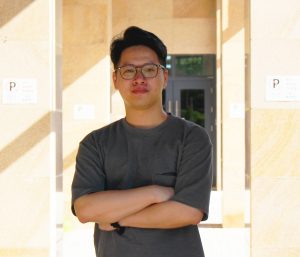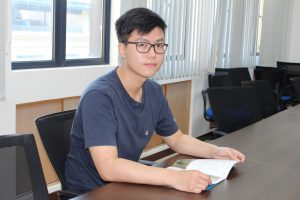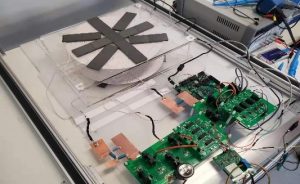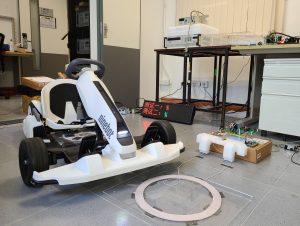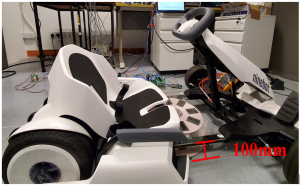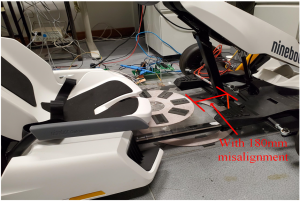Living up to expectations, bringing honor to UM
Iam Io Wa (Paul) and Hoi Iok U (Charles) are the outstanding graduates of the Department of Electrical and Computer Engineering this academic year. Since they are good at studying wireless battery charging system, their final year project is about inductive power transfer system for wireless battery charging. When talking about their achievements from the final year project, Paul says, ‘I have achieved more practical experiences than I thought from the whole research and it is the knowledge that I cannot get from books. We need to do many experiments and apply our critical thinking skills during the whole process. I am very grateful for the support and encouragement of professors.’ For Paul who had secondary education at Mainland China, there are many reasons that he decided to come to UM in the first place. ‘Because my family has business related to electron, and I am a person who like to do some handiworks. Compared with other universities, UM has the State Key Lab (State Key Lab of Analog and Mixed-Signal VLSI) and that is very attractive to me.’ Paul says. Charles, who studied in St. Paul’s College for secondary education, ‘There was a power outage happened at home once, which motivated me to learn more. I chose UM is because here has the subject I want.’ he says. For the final year project, ‘I really appreciated the opportunity to get to know different equipment. But at the same time, I also realized that creating a wireless charging system is not just about manufacturing, but also need to consider various safety issues.’ Charles says.
Academic level far exceeds undergraduates
They have published multiple research papers in the past few years, including 4 conference papers and 1 journal paper. The journal paper has been successfully accepted as the SCI Q1 paper, which is a great honor and recognition for undergraduate. (Click here to see the paper: https://ieeexplore.ieee.org/document/9122562) Except for publishing papers, they also won many awards in the past. With the ‘wireless charging of electric vehicles’, they successfully won the 4th prize out of 36 teams in 2020 Bank of China Trophy One Million Dollar Macao Regional Entrepreneurship Competition; They won the champion and practicability award in 2020 and 2019 IEEE project competition, Macau student branch. In June, 2020, they also won the champion of 2020 IEEE Industrial Electronics Society (IES) undergraduate contest.
The establishment of future wireless charging system
According to the findings of global market insights, by 2026, the global wireless charging market will be raised to USD 30 billion, the demand for wireless charging is going to expand rapidly. In response to this trend, Paul and Charles develop a dynamic and static charging system for mobile phones, electric cars, robots and home appliances. They believed that diesel vehicle will soon be replaced by electrocar which is known as greener and less polluting. Therefore, they designed a self-contained solar-powered inductive power transfer system and a constant-frequency non-communication-based IPT converter for static battery charging (e.g. electric vehicles). The advantages of this system and converter are high charging efficiency, no wiring requires and more cost effective than centralized solar-powered EV charging station. Paul and Charles mentioned that many warehouses or factories in Mainland China now require the assistance of robots in sorting, packing and transporting delivery packages. Wireless charging system can greatly increase the work efficiency of robot since it allows the robot to charge while working. The charging system will help to reduce the logistic workload especially during online shopping festivals (e.g. double eleventh day). For this purpose, they also developed a wireless charger for dynamic charging battery. By using a mini electric vehicle as a demonstration, the charger can effectively charge even through there are 40% misalignment of the vehicle and the charger.
Great mentors make excellent performance
In regards of the excellent results they achieved from final year project and other competitions, they are grateful to professors who ever have guided, taught and encouraged them throughout the university life, such as Prof. Chi-Seng Lam and Dr. Zhicong Huang who are the supervisors of their final year project. They even published a paper with Dr Huang which was awarded as the ‘Best Track Paper’ at the 11th IEEE Asia Pacific Power and Energy Engineering Conference. For Prof. Chi-Seng Lam, they say, ‘Except for teaching us problem solving skills, he also taught us how to write and publish an academic paper, so we could fully concentrated on researching.’ Their journal paper successfully accepted as the SCI Q1 paper has given their confidence in keep continuing their research. Now, Paul and Charles have been accepted by UM for their Ph.D. and master degree application. They are looking forward to continuing their wireless charging research so as to explore a broader and further way in future application.
不負眾望,為校爭光
任耀華和許旭宇是本學年本科電機及電腦工程系畢業生,兩人憑著 “無線電池充電系統” 作為畢業設計項目成為今屆優秀畢業生。提及從本次項目中學到什麼時,耀華同學說:「畢業設計項目令我獲得了更多實踐的經驗,這些都是書本上學不到的知識,製作過程都需要不斷構思和做實驗,我也很感謝多位教授的支持和鼓勵。」對於中學在內地讀書的耀華來說,當初就讀澳大的原因有很多。「因為家人是做電子行業,而我自己是一個喜歡動手創造的人,而澳大又有模擬與混合信號超大規模集成電路國家重點實驗室。再比較鄰近地方的大學,覺得澳大的條件及環境都非常吸引。」而旭宇同學中學則是在澳門聖保祿學校就讀,他分享說:「我選擇澳大的原因是家裡有一次停電跳錶,讓我有了想要了解的興趣和動力,而澳大裡剛好就有電機及電腦工程系,所以最終選擇澳大。」對於畢業設計項目,旭宇說: 「過程中令我有機會接觸到不同設備,慢慢學習然後深入了解,但同時也明白到原來並非把成品製造出來就可以,還需要考慮各種安全問題。」
曾發表多篇高質論文,實力超本科生水平
兩人過往曾發表多篇論文,包括4篇會議論文及1篇期刊論文。其中期刊論文“Constant-Frequency and Non-Communication-Based Inductive Power Transfer Converter for Battery Charging”在經過3次審議後,獲採納為SCI 一區的論文,已達國際頂級水平及博士生水準,對於本科生來說已是極大的認可。(文章可按此瀏覽: https://ieeexplore.ieee.org/document/9122562) 兩人合作無間,先後獲得眾多獎項,例如,憑著“電動汽車的無線充電”在2020中銀盃百萬獎金澳門區創業大賽成功突圍, 36個參賽隊伍中獲得第4名;在2020及2019國際電機及電子工程師學會 (IEEE) 澳門分會主辦的科研比賽中,獲得冠軍及最佳實用價值獎。不久前,兩人也在2020年工業電子學會本科生項目比賽中奪冠。
建設未來無線充電系統
根據Global Market Insights的研究,直到2026年,全球無線充電市場規模將達到300億美元,無線充電的需求正不斷擴大。為此,兩人也朝著這方向發揮,積極研發動態及靜態電池無線充電系統,為手機、電動車、機器人以及家電作無線充電。兩人認為電油車在不久將來將被淘汰,取而代之的是較環保及沒有污染的電動車。因此,在靜態電池充電如電動車,他們設計出一個自給式太陽能感應功率傳輸系統以及恆定頻率非通信式的感應功率傳輸轉換器。該系統在整個充電過程中均具有高效率,不需要接線且造價成本比傳統的集中式太陽能電動汽車充電站更低。另外,耀華和旭宇也提到,目前很多大型倉庫或工廠都需要機械人24小時協助整理,包裝及運輸貨物。無線充電可以令機械人可以一邊工作一邊充電,不需要停下來接線,大大增加了工作效率。如若碰上內地網上購物節(雙十一等),可以有效緩解物流的壓力。為此畢業設計項目中,他們還設計出一種為動態電池充電的無線充電系統。並以一部迷你電動車做示範。即使在與充電器有近40%偏移的情況下,仍然能夠有效充電。
良師益友,成就優秀表現
4年光陰,換來優秀成績及難忘經驗,全憑著一班良師益友的幫助。耀華及旭宇坦言有很多教授及研究人員需要感謝,例如他們的指導老師黃智聰博士及林智聲教授,兩人早前更與黃智聰博士共同發表論文,並在第11屆IEEE亞太電力和能源工程會議上發表,結果獲得了“Best Track Paper Award”的獎項。在畢業設計項目中,兩人均表示感謝林智聲老師,「除了指導我們在研究上如何解決問題,怎麼走下一步,還教導我們如何寫論文,及將一份論文正式地發表,讓我們可以心無旁騖,專心研究。」期刊論文獲採納為SCI 一區的文章,為他們打下強心針。目前,兩位同學已獲得澳大博士及碩士錄取通知,他們期望能繼續研究無線充電,把技術應用在市場及研發新項目上,向更遠更廣的研究之路進發。
The outstanding student of ECE, Paul Iam
電機及電腦工程系優秀學生 – 任耀華
The outstanding student of ECE, Charles Hoi
電機及電腦工程系優秀學生 – 許旭宇
Self-Contained Solar-Powered Inductive Power Transfer System
自給自足太陽能感應電力傳輸系統
A wireless charger for mini electric vehicle
無線充電系統為迷你電動車充電
Even in the case of nearly 40% misalignment, it can still charge
即使有近40%偏移的情況,仍然能夠充電


